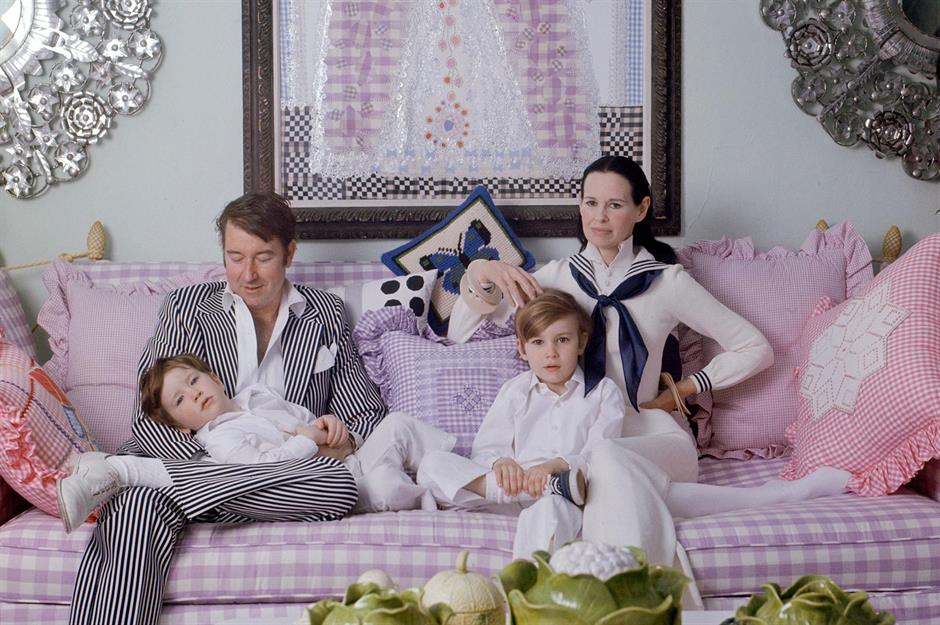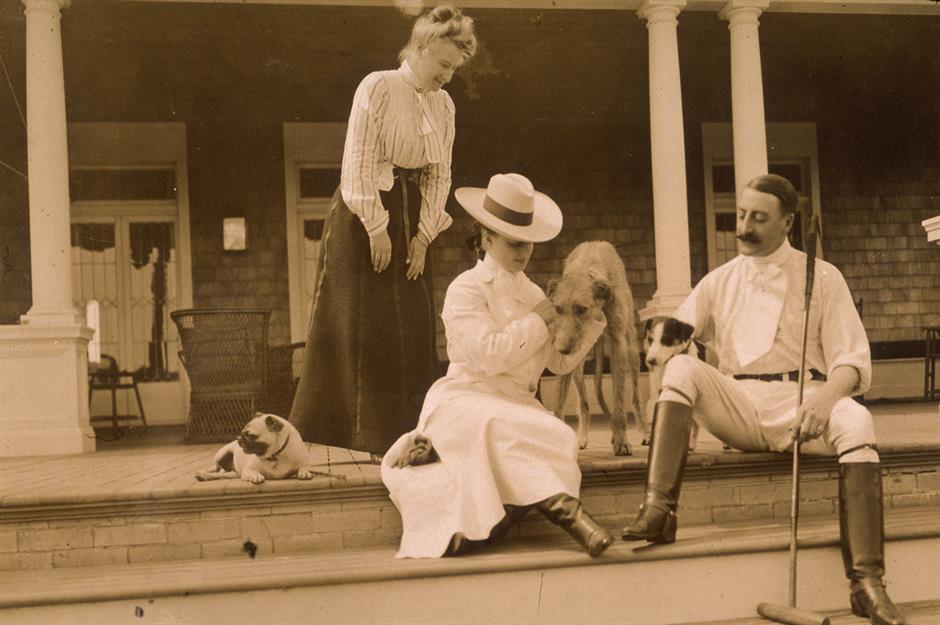Archival images reveal high life in the Hamptons: playground of America’s elite
Welcome to the Hamptons

Famously a retreat for the rich and famous, the Hamptons is a collection of hamlets scattered across the scenic coastline of New York’s Long Island.
From Southampton to East Hampton, Bridgehampton to Montauk, the area is packed with high-end shopping, five-star restaurants, and glittering nightlife. But how did it become such an elite haven? And who inhabited those stunning mansions sequestered behind box hedgerows?
Click or scroll to take a stroll through the Hamptons’ rich history…
1893: the dawn of a new era

The 1890s saw the dawning of a new age for the Hamptons, as the whaling industry, which had been its primary trade, waned.
The foundation of the Maidstone Club (a glamorous golf and country club) and the coming of the Long Island Railroad opened the island up to tourism.
Affluent, urban New Yorkers came to enjoy lush farmland, glittering, peaceful seascapes, and found plenty of room to build summer estates like this one.
1902: the wealthy escape to the Hamptons

Many urban escapees found the Hamptons so alluring that they decided to build their own summer homes, like the East Hampton one pictured here, belonging to actor John Drew and his wife.
The typical Hamptons home was characterised by unpainted weatherboard cladding, as the rough ocean breezes would be too damaging.
Other features include white trim, steeply slanting rooflines, and covered porches for enjoying balmy summer evenings, as the Drew family can be seen doing here.
1914: luxurious outdoor spaces

Some mansions were more extravagant in their design, such as Colonel Henry Huttleston Rogers’ Spanish Colonial-inspired Black Point, pictured here.
A common theme for most estates, however, was the cultivation of spectacular manicured grounds and gardens, including those designed by the celebrated Olmstead Brothers for Black Point.
These grounds were the ideal places for solitary relaxation, or, more commonly, for lavish entertaining, as we will see…
1922: the Bright Young Things arrive

The 1920s saw the coming of New York’s socialite set to the Hamptons, including Mr. A. B. Duke and Miss Dorothy Steward, pictured here posing dramatically in Mr. Duke's Rolls-Royce in front of a row of beach cottages.
The best and brightest fled the city heat in favour of beachy breezes, but kept the party roaring on.
Famously, writer F. Scott Fitzgerald and his flapper wife Zelda spent a summer on the island, which went on to inspire The Great Gatsby.
1924: summer living

Of course, not every Hamptons residence was a glittering palace worthy of Jay Gatsby.
Pictured here is a quintessential example of a slightly more modest Hamptons summer home, the East Hampton residence of prominent New Yorker and State Supreme Court Justice Edward Everett McCall.
Low eaves, weatherworn cladding, and plenty of sun porches show that this house was designed with hot summer living in mind.
1931: entertaining outdoors

Hamptons living embodied the ideal of indoor/outdoor entertaining, and most homes were designed to make this transition seamlessly, elegantly, and with flair.
Porches and terraces were spacious, capable of hosting cocktail parties, elaborate dinners, and even dancing, as can be seen in this snap from a party at The Shallows Estate in Southampton in 1931.
1933: the East Hampton Hunt

The English tradition of the hunt also made its way out to the Hamptons as a pastime for the sportier of the social elite, who already favoured Long Island for its equestrian facilities.
In this snapshot of the East Hampton Hunt in 1933, smartly clad guests kitted out for a day of riding cluster together on the lawn outside a fashionable home.
1953: artists in the Hamptons

By the 1950s, artists began flocking to the Hamptons, setting up enclaves in Sag Harbor and Bridgehampton. Among their number were Lee Krasner, Balcomb Greene, and Jackson Pollock, pictured here in the studio of his East Hampton home.
While Pollock and Krasner had their own Hamptons home, they, like many artists, flocked to ‘The Springs’, a home owned by Italian sculptor Constantino Nivola, which became something of a haven for creatives and luminaries during the decade.
1955: wealth and prosperity

The 1950s in the Hamptons were as vivid and flush with ready money as they were for the rest of America, with people eager to splash out on new clothes, homes, and interiors.
This snap from 1955 depicts a quintessential scene from the decade: a family enjoying a day at the beach, decked out in stylish swimwear and all the accoutrements, with a new build, stately white beach house in the background.
1962: a writers' retreat

Writers also found sanctuary in the bucolic surroundings of the Hamptons. Pictured here, John Steinbeck, author of The Grapes of Wrath, leans against the dramatic fireplace in his Sag Harbor home, adorned with hunting horns, rifles, and pistols.
Every summer, the Steinbecks would close up their East Side Manhattan apartment, retreating to their tranquil island cottage, where Steinbeck even had a tiny writing shed perched on the waterfront. It was here that he penned The Winter of Our Discontent, which was inspired by Sag Harbor.
1966: modern architecture creeps in

By the mid-1960s, more modern architectural styles were cropping up around the Hamptons, like this home belonging, appropriately, to architect and urban planner Paul Lester Wiener.
While it still features the white trim and weatherboard cladding typical of Hamptons builds, the slats are now positioned in a more contemporary vertical style to create the popular ‘Scandi barn’ look.
The new design trend was soon common around the Hamptons, melding thematically with the island’s agricultural landscape.
1971: bohemia to Babylon

Arguably the Hamptons’ most vivid decade, the 1970s saw the island turn a corner towards the opulent, wealthy playground we associate it with today. As the US entered what has been coined the "Me decade", characterised by individualism, consumption, and conspicuous luxury, the Hamptons became a haven for a new social set: the uber wealthy.
Truman Capote, pictured here in his Sagaponack home, is the perfect embodiment of this era of transition, having built a reputation as an outrageous socialite off the back of a once-prestigious writing career.
1972: Gloria Vanderbilt at home

Heiress of the prominent Vanderbilt family, perhaps better known for her role in the advent of designer denim, Gloria Vanderbilt is pictured here in her glamorous Southampton home, reading a bedtime story to her two sons.
The Vanderbilt-Coopers were the epitome of New York’s elite in the 1970s, and their Hamptons home was a reflection of all the luxury, style, and taste the pair were expected to embody... which apparently meant a lot of gingham.
1972: Hamptons home shoots

Pictured here in another snap from the same shoot, Gloria poses with her sons and husband on a gingham-clad couch covered in ruffled pillows.
Household shoots like this one were just becoming popular in the 1970s, an opportunity for celebrities and social tastemakers to show off their design savvy and domestic artistry by using their home as a highly stylised backdrop for their glamorous lives.
A painter and designer as well as a socialite, Gloria was certainly up to the challenge.
1975: Grey Gardens

However, not all Hamptons residents made this transition from old to new quite so gracefully. This haunting photo from 1975 depicts Edith Bouvier Beale, better known as ‘Little Edie’, the former socialite and fashion model-turned recluse.
Edie’s eccentric life with her mother, another former socialite and aunt to Jackie Kennedy, was notoriously exposed in the 1975 documentary Grey Gardens, which depicted the women living in squalor and nearly complete isolation in their crumbling Long Island estate.
1977: Ralph Lauren's Hamptons home

Celebrated fashion designer Ralph Lauren also claimed the Hamptons for his own in the 1970s, showcasing his collections there, buying homes in East Hampton and Montauk and incorporating the area’s summery, equestrian-chic aesthetics into his fashion lines.
Lauren is pictured here in November 1977 with his wife and children going for a stroll outside their quintessential East Hampton home, which makes the perfect backdrop for the fashionable family.
1977: projecting chic

Another photo from the same shoot takes us inside the family living room, featuring Ralph and his wife, Ricky, warming their toes in front of the fireplace.
The couple were considered the epitome of the rugged, effortless chicness pioneered by Lauren and aspired to by many. Their home’s décor reflects this style, with its large brick fireplace, animal skin rug, and chintzy furnishings just visible in the background.
1978: the Hamptons model

Models could be found haunting the Hamptons, too, either actively shooting advertising campaigns or hoping to catch the eye of a prominent designer or director.
This photo features model Janice Dickinson napping on a bed in a modern Amagansett beach house designed by Gwathmey and Siegel Architects.
It was part of an ad campaign for Wamsutta sheets, featuring Calvin Klein designs, which, like many similar, capitalised on the glamour of Hamptons living, suggesting it could be emulated with the purchase of certain products.
1979: timeless aesthetics

While Hamptons homes continued to evolve with various architectural and interior design trends, they generally maintained summery, beachy aesthetics with bright, airy spaces, plenty of natural light, and a focus on seamless indoor/outdoor living.
The East Hampton living room of author Joseph Heller, pictured here in 1979, is a perfect example. Modern floor-to-ceiling windows flood the space with light, while floral print fabric and basket-woven furnishings create a garden-like feel.
1984: the Bohemians of the Hamptons

As the 1970s faded into the 80s and 90s, the Hamptons population diversified. While it was still dominated by the uber-wealthy tastemakers, it also became home once more to bohemians, creatives, and even young people, busing out from Manhattan to rent tumbledown beach cottages for the weekend.
This eclectic kitchen is the Sag Harbor home of publisher and editor Jason Epstein, a cosy haven packed with burnished brass pots, Tuscan-style swags of garlic, and lots of hanging storm lamps.
Loved this? Now discover more of America's most luxurious homes
Comments
Be the first to comment
Do you want to comment on this article? You need to be signed in for this feature